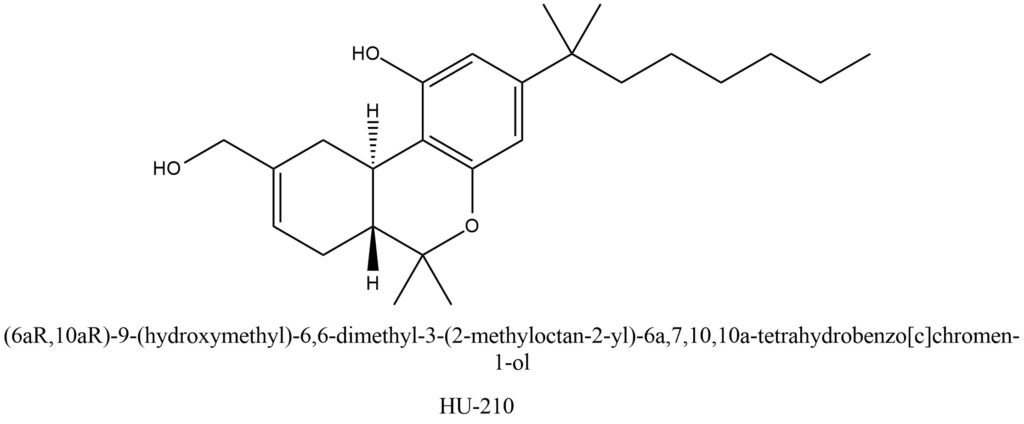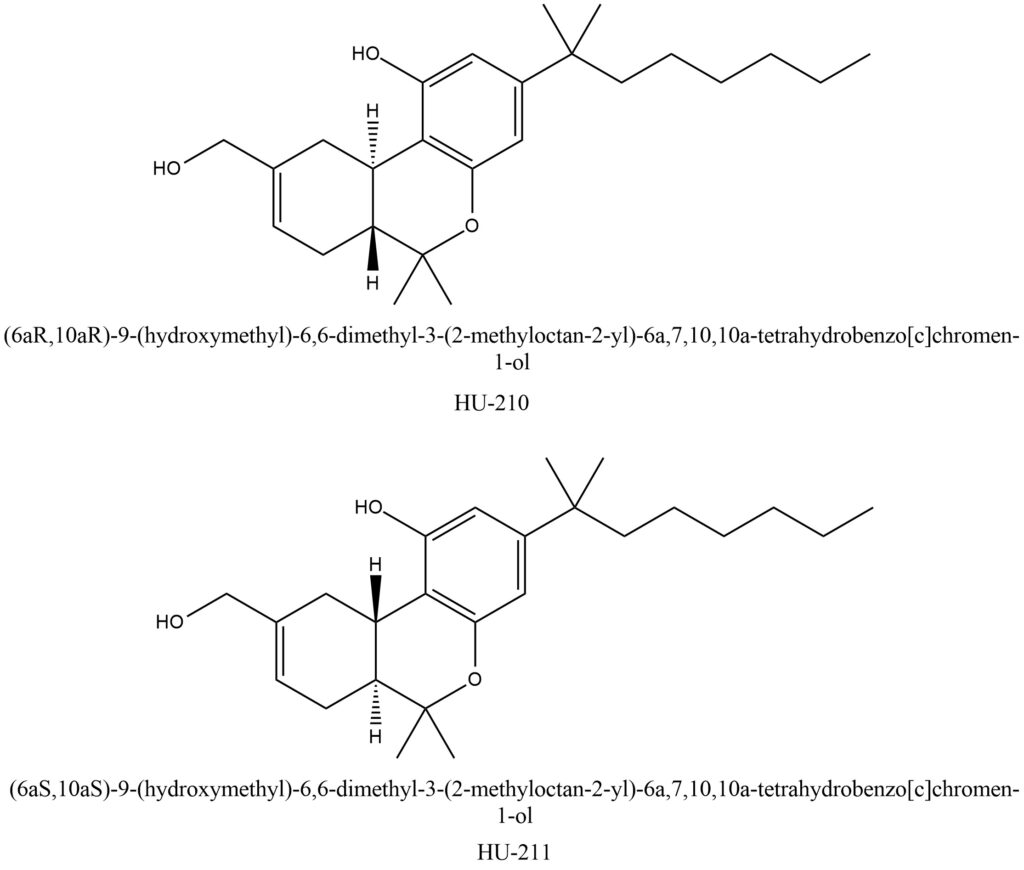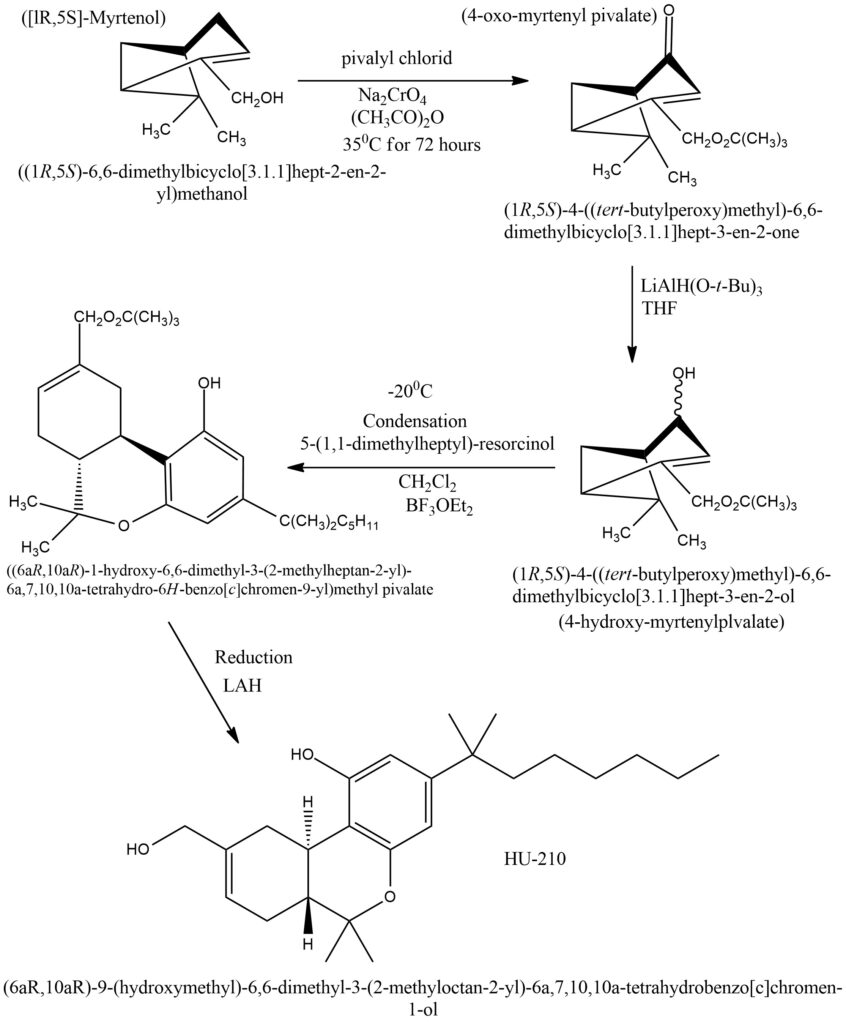- The process of creating a drug - May 23, 2023
- How do scientists model mental disorders in animals? - May 23, 2023
Abstract
This article provides a comprehensive overview of the HU-210 cannabinoid, covering its physico-chemical properties, pharmacology, effects of use, street names, prices, approximate dosage, and method of synthesis.
General Information About HU-210 Synthetic Cannabinoid [1]
Other synonyms names of HU-210 are:
CHEMBL307696; HU210; (-)-HU-210; (6aR)-trans-3-(1,1-Dimethylheptyl)-6a,7,10,10a-tetrahydro-1-hydroxy-6,6-dimethyl-6H-dibenzo[b,d]pyran-9-methanol; 6H-DIBENZO(B,D)PYRAN-9-METHANOL, 3-(1,1-DIMETHYLHEPTYL)-6A,7,10,10A-TETRAHYDRO-1-HYDROXY-6,6-DIMETHYL-, (6AR,10AR)-
IUPAC Name of HU-210:
(6aR,10aR)-9-(hydroxymethyl)-6,6-dimethyl-3-(2-methyloctan-2-yl)-6a,7,10,10a-tetrahydrobenzo[c]chromen-1-ol
CAS number is 112830-95-2
Deleted or Replaced CAS Registry Numbers 182205-63-6
Analogs of HU-210 are HU 211, 239, 243, 308, 320, 331, 336, 345; (6aR-trans)-isomer; dexanabinol; Dronabinol; Synhexyl; WIN 55,212-2; JWH-133; delta-8-Tetrahydrocannabinol (Delta-8-THC); 6,6,9-Trimethyl-3-pentyl-6a,7,8,10a-tetrahydrobenzo[c]chromen-1-ol and other.
Physico-Chemical Properties of HU-210 [1]
- Molecular Formula C25H38O3
- Molecular Weight 386.57 [2]
- Melting point -98 °C
- Boiling point 68-73 °C
- Ignition temperature 455 °C
- Flammability (solid, gaseous) Highly flammable
- Soluble to 100 mM in ethanol and to 100 mM in DMSO [3]
- SOLUBILITY Methanol 15 mg/ml; DMF 50 mg/ml; DMSO 50 mg/ml; Ethanol 50 mg/ml; PBS (pH 7.2) 2 mg/ml
Structural formula present on Figure 1.

Figure 1. Structure of HU-210
Powder possible HU-210 present on Figure 2.

Figure 2. Powder of HU-210
HU-210 is the enantiomer of HU-211 (Figure 3)

Figure 3. HU-210 is the enantiomer of HU-211
General Information of HU-210 in Recreational Use and Pharmacology [1,4]
Pharmacology Used
HU-210 is a full agonist of the CB1R/CB2R and is used for the prevention and treatment of cardiac arrhythmias. It affects various aspects of the action potential, including the polarization-repolarization phase, excitability or refractoriness, impulse conduction, and membrane responsiveness in cardiac fibers. There are four main groups of anti-arrhythmia agents based on their mechanism of action, including sodium channel blockade, beta-adrenergic blockade, repolarization prolongation, or calcium channel blockade [1]. HU-210 is also used to prevent nausea or vomiting.
Excitatory amino acid antagonists are drugs that bind to but do not activate excitatory amino acid receptors, blocking the actions of agonists. HU-210 is a potent analgesic with effects similar to natural THC. It is also a neuroprotective agent, preventing damage to the brain or spinal cord from ischemia, stroke, convulsions, or trauma. Some neuroprotective agents must be administered before the event, while others may be effective for some time after. They act by various mechanisms, often minimizing damage produced by endogenous excitatory amino acids.
Cannabinoids and their derivatives are of great interest due to their potential psychoactive effects for treating psychiatric disorders and symptoms. However, their clinical application is limited by various side effects, including impaired coordination, anxiety, and learning and memory disability. The dorsal striatum-dependent learning is particularly affected by cannabinoids. Reinforcement learning is one of the most important forms of learning mediated by the dorsal striatum, characterized by an initial association learning phase, followed by habit learning. While the effects of cannabinoids on habit learning have been extensively studied, little is known about how they influence the initial phase of reinforcement learning.
Research has shown that acute activation of the cannabinoid receptor type 1 (CB1R) by the synthetic cannabinoid HU210 impairs dose-dependent association learning, which can be alleviated by the intra-dorsomedial striatum (DMS) injection of a CB1R antagonist. Furthermore, acute exposure to HU210 elicited enhanced synaptic transmission in striatonigral “direct” pathway medium spiny neurons (MSNs) but not in indirect pathway neurons in DMS. Interestingly, enhancement of synaptic transmission observed after learning was abolished by HU210, indicating that the cannabinoid system may disrupt reinforcement learning by confounding synaptic plasticity required for learning. Notably, impaired response-reinforcer learning was also induced by selectively enhancing the activity of dopamine receptor type 1 (D1-MSN) through the virally expressed excitatory hM3Dq DREADD, which could be rescued by specifically silencing the D1-MSN activity via hM4Di DREADD [4].
Effects of Cannabinoid Use [4, 5]
HU-210, a potent analgesic, has been found to have similar effects as natural THC. Recent research indicates that acute administration of HU-210 can affect association learning and motor activities in a dose-dependent manner, as well as decrease body temperature. The impairment of learning is thought to be mediated by dysfunctional synaptic enhancement. Interestingly, it has been reported that high-dose administration of HU-210 in stressed mice leads to deficits in motor activities, indicating an interaction effect between stress and drug administration. Persistent exposure to cannabinoid receptor agonists during adolescence has been shown to increase depressive-like behaviors, posing a challenge to the development of cannabinoid-based therapies. However, chronic adolescent exposure to HU-210 only induced a short-term increase in stress-reactivity and did not significantly impact anxious or depressive-like behaviors in adulthood. Notably, there have been no published studies on the psychotropic effects of HU-210 in humans. A mouse treated with HU210 at a dose of 15 μg/kg showed obvious stress responses when receiving footshocks as training began showed on the Video 1.
Street Names, Prices and Approximate Dosage [5-8]
HU-210 is a synthetic cannabinoid that is reportedly 100 times more potent than THC. It is often found in the so-called “herbal mixture” known as “Spice,” which is commonly smoked for its psychoactive effects under names such as Genie and Yukatan. In the United States, a package of Spice weighing approximately 3 grams can cost around $35, while in European countries it can cost around 25€. According to research, 25-100 μg/kg of HU-210 should be equivalent to doses of THC ranging from 2.5-10 mg/kg [5].
In animal studies, HU-210 has an oral LD50 of 5,000mg/kg in rats and 14,200mg/kg in rabbits. In humans, the LDLO (Lowest Lethal Dose amount) of HU-210 has been reported to be 143mg/kg [6], which is significantly lower than the estimated LD50 of caffeine, which ranges from 150-200 milligrams per kilogram [7]. However, the LD50 of Delta-8-THC has not been confirmed. In a 1973 study, monkeys and dogs were given doses of 9,000mg/kg of Delta-8-THC, which was found to be nonlethal [8].
Legal Status
Although HU-210 is not included in the schedules set out by the United Nations’ Single Convention on Narcotic Drugs from 1961 nor their Convention on Psychotropic Substances from 1971, different countries have taken different approaches to controlling its use. For instance, New Zealand banned HU-210 as of 8 May 2014 [9]. In the USA, HU-210 is considered a Schedule I controlled substance under the Controlled Substances Act (CSA) in states such as Alabama and Florida because it is believed to be an analogue of Delta-8-THC [10, 11, 12]. Additionally, in Vermont, HU-210 has been regulated as a “Hallucinogenic Drug” since January 1, 2016 [13].
Synthesis of (6aR,10aR)-9-(hydroxymethyl)-6,6-dimethyl-3-(2-methyloctan-2-yl)-6a,7,10,10a-tetrahydrobenzo[c]chromen-1-ol [14]
HU-210 is a synthetic cannabinoid that was first synthesized in 1988. The synthetic process for HU-210 is outlined in Figure 4, with more specific details available in [14]. To begin, [1S,5R]-myrtenol is obtained through the oxidation of a-pinene. HU-210 can then be synthesized from [1R,5S]-myrtenol, while HU-211 can be synthesized from [1S,5R]-myrtenol. General sheme on Figure 4.

Figure 4. General scheme of HU-210 synthesis
Conclusion
To date, there have not been any studies published on the psychotropic effects of HU-210 in humans, despite its synthetic cannabinoid nature and discovery in 1988. HU-210 is reputedly 100 times more potent than THC, and is a powerful analgesic with effects comparable to those of natural THC. In the United States, a typical package of Spice weighing roughly 3 grams can fetch around $35, whereas in Europe, the cost may be around 25€.
Bibliography
- https://pubchem.ncbi.nlm.nih.gov/compound/9821569#section=Isomeric-SMILES
- https://commonchemistry.cas.org/detail?cas_rn=112830-95-2
- https://www.chemspider.com/Chemical-Structure.7997318.html
- Meilin Wu, Yuanyuan Di etc. Acute cannabinoids impair association learning via selectively enhancing synaptic transmission in striatonigral neurons. BMC Biology, 2022, 13;20(1):108. doi: 10.1186/s12915-022-01307-1. https://pubmed.ncbi.nlm.nih.gov/35550070/
- Miguel Farinha-Ferreira, Nádia Rei etc. Unexpected short- and long-term effects of chronic adolescent HU-210 exposure on emotional behavior. Neuropharmacology, 2022, Vol. 214, 109155. DOI: 10.1016/j.neuropharm.2022.109155. https://pubmed.ncbi.nlm.nih.gov/35660545/
- HU-210 Safety Data Sheet. https://cdn.caymanchem.com/cdn/msds/90083m.pdf
- JOSEF M. PETERS Factors Affecting Caffeine Toxicity: A Review of the Literature. The Journal of Clinical Pharmacology and The Journal of New Drugs, 1967, Vol.7, Issue 3, pp. 131-141. https://doi.org/10.1002/j.1552-4604.1967.tb00034.x https://accp1.onlinelibrary.wiley.com/doi/10.1002/j.1552-4604.1967.tb00034.x
- Thompson GR, Rosenkrantz H, Schaeppi UH, Braude MC (July 1973). “Comparison of acute oral toxicity of cannabinoids in rats, dogs and monkeys”. Toxicology and Applied Pharmacology. 25 (3): 363–72. doi:10.1016/0041-008X(73)90310-4 https://www.sciencedirect.com/science/article/abs/pii/0041008X73903104?via%3Dihub
- https://web.archive.org/web/20150921191334/http://www.drugfoundation.org.nz/synthetic-cannabinoids/what-they-are
- HU-210, Purported Ingredient of “Spice”. Drug Enforcement Administration, Diversion Control Division, Drug & Chemical Evaluation Section. https://www.deadiversion.usdoj.gov/drug_chem_info/spice/spice_hu210.pdf
- https://legiscan.com/AL/text/SB333/2014
- http://leg.state.fl.us/statutes/index.cfm?App_mode=Display_Statute&URL=0800-0899/0893/0893.html
- http://healthvermont.gov/sites/default/files/documents/2017/01/REG_regulated–drugs.pdf
- Raphael Mechoulam, Naftali Lander Synthesis of the individual, pharmacologically distinct, enantiomers of a tetrahydrocannabinol derivative. Tetrahedron: Asymmetry, Volume 1, Issue 5, 1990, Pages 315-318. https://doi.org/10.1016/S0957-4166(00)86322-3 https://www.sciencedirect.com/science/article/abs/pii/S0957416600863223?via%3Dihub


